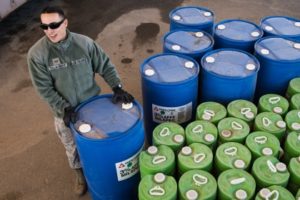Exposure Linked to Cancer, Other Health Events

In 2017, Senior Airman Francisco Villalobos, 407th Expeditionary Civil Engineer Squadron firefighter, moved a 55-gallon drum while transferring fire retardant from a foam trailer at the 407th Air Expeditionary Group. The unit switched all the fire retardant foam in their inventory as part of an Air Force-wide initiative to use more environmentally friendly foam. U.S. Air Force photo/Master Sgt. Benjamin Wilson
WASHINGTON — DoD officials have been called to defend the military’s ongoing clean-up and exposure tracing efforts related to its use of polyfluoroalkyl substances (PFAS), which are contained in, among other things, fire-retardant foam.
The use of this foam has resulted in the contamination of some military bases and surrounding communities. Now understood to be an environmental hazard, PFAS also has been linked to a number of adverse health events, including some cancers. The substances have developed the nickname “forever chemicals” because of their ability to build up in the body over time.
Military officials took heat last month from members of the Senate Homeland Security Committee. The legislators cited a DoD Inspector General report, published in July, that shows that DoD knew about the potential dangers of PFAS years prior to taking any action.
“Despite information that PFAS exposure presented health and environmental risk, the Department of Defense failed to warn servicemembers, their families, and communities about these risks for five years, unnecessarily putting them in harm’s way,” declared Committee Chair Sen. Gary Peters (D-MI). “DoD has been reluctant to accept responsibility in their role to contributing to the PFAS exposure crisis and have been slow to take vital action. The department also lacks a comprehensive approach across its branches to better identify areas of contamination, mitigating exposure and clean up PFAS contamination, including sources that go well beyond firefighting posts.”
The IG report shows that DoD’s Emerging Chemical (EC) Program put out a risk alert for PFAS in 2011, describing risks to DoD areas of concern, including health and the environment. However, the alert was not considered a “risk management action,” because it was not endorsed by DoD’s Emerging Chemicals of Concern Governance Council. Consequently, DoD was not required to plan, program or budget for any action in response to the alert.
It was not until 2016 that the EPA issued a final health advisory and EC Program officials began requiring proactive risk management actions.
“This occurred because [DoD regulations do not] include objective requirements for EC Program officials to use when determining when to initiative risk management actions or to elevate an EC from the EC Watch List to the EC Action List,” the IG report states. “As a result, people and the environment may have been exposed to preventable risks from PFAS-containing [fire-retardant foam].”
Track, Trend, Analyze
Since 2016, DoD has attempted to identify populations exposed to PFAS and inform them of the health concerns. DoD regulations require them to track, trend and analyze clinical examination results related to workplace exposures.
Faced with an IG report that suggests the military could have acted five years earlier, DoD officials defended their response, and noted that the same unclear rules and lack of hard data on PFAS that delayed them in the last decade will delay clean-up and mitigation efforts in the next one.
“It’s still unclear what exposures and at what levels result in adverse health effects. The EPA has published analytic methods to detect fewer than 10% [of PFAS],” explained Richard Kidd, DoD deputy assistant secretary for environment and energy resilience. “The lack of this clear set of measurable and objective health and environmental standards complicates our ability to take proactive actions. These uncertainties extend to our clean-up efforts. Based on what we know today, it will take years to define the scope of our clean-up and decades before it is complete.”
Asked whether it was fair to say that DoD unnecessarily delayed its response, Kidd said that it was not.
“The IG report tells us that we have to be proactive but that we also must make objective decisions against measurable outcomes,” he said. “How can we be proactive if we don’t have a measurable metric?”
Complicating matters is the fact that PFAS contamination is present to some extent nearly everywhere in the country.
“PFAS are not uniquely attributable to DoD activities. It is extremely difficult to measure DoD firefighters’ exposure to PFAS in their occupational setting and to differentiate that from other exposures to PFAS,” explained Laura Macaluso, acting DoD deputy assistant secretary for force safety and occupational health. “Results on scientific research on health effects are needed before we can implement occupational exposure limits.”
